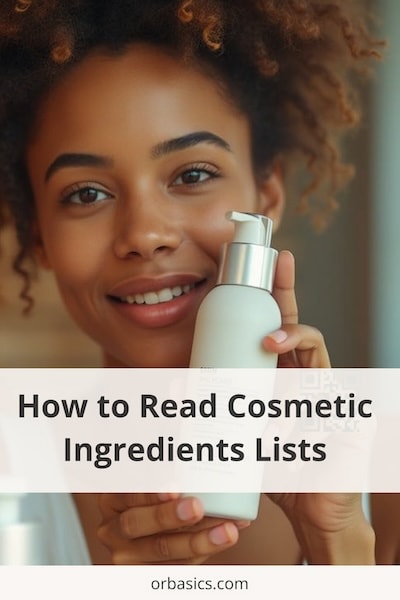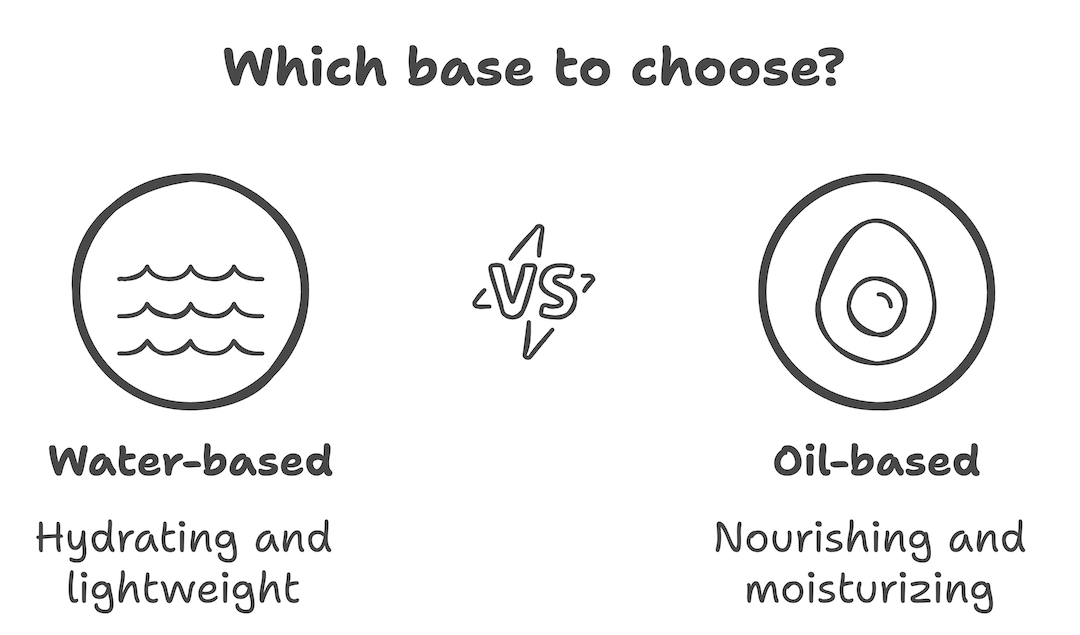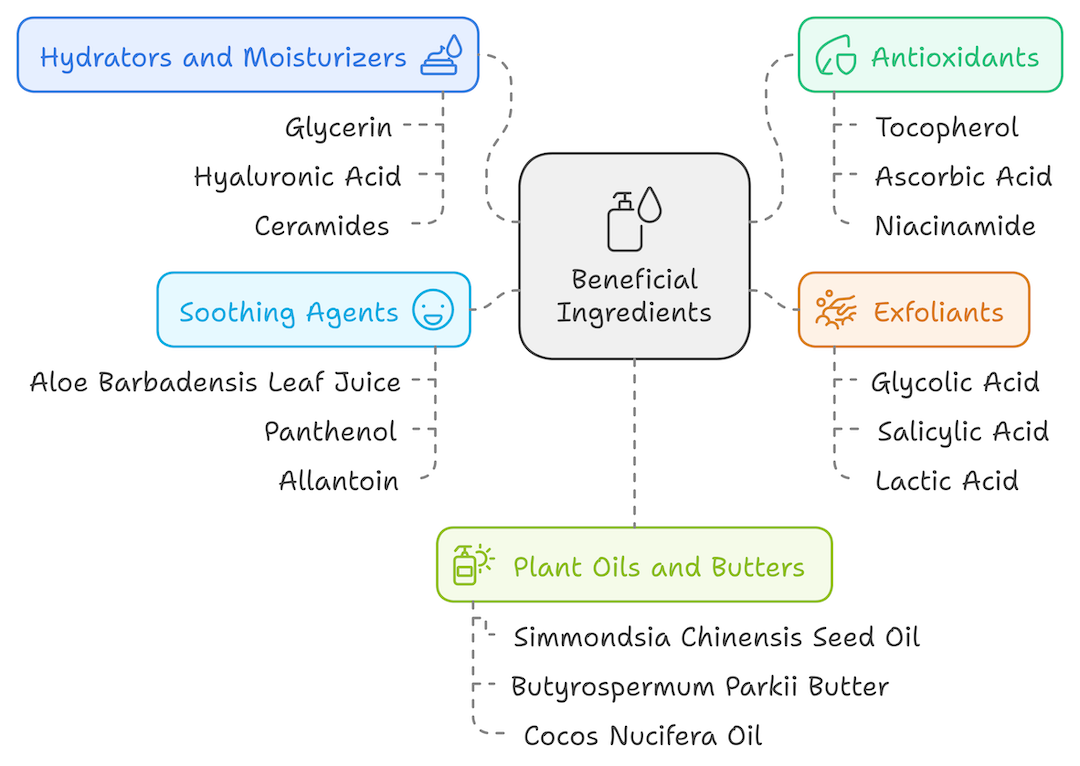Table of Contents
INCI-Liste entschlüsselt: Inhaltsstofflisten lesen wie ein Profi
This page may contain affiliate links. We may earn a commission on purchases, at no additional cost to you. Learn more →
Hast du schon mal ein Beautyprodukt in die Hand genommen und dich von der langen Liste unbekannter Inhaltsstoffe auf dem Etikett überfordert gefühlt? Damit bist du nicht allein. Die Welt der Kosmetik kann überwältigend sein.
In der heutigen Welt der Informationsflut kann das Entschlüsseln dessen, was in unserer Kosmetik enthalten ist, sich anfühlen wie ein Crashkurs in Chemie.
Aber es gibt einen Schlüssel zur Lösung dieses Rätsels: die INCI-Liste.
INCI, die Abkürzung für "International Nomenclature of Cosmetic Ingredients" (Internationale Nomenklatur für kosmetische Inhaltsstoffe), ist ein standardisiertes System zur Bezeichnung von Inhaltsstoffen in Kosmetika. Es ist im Grunde eine universelle Sprache für kosmetische Formulierungen, die entwickelt wurde, um Verbrauchern weltweit Klarheit zu verschaffen.
Egal, ob du eine Feuchtigkeitscreme in New York, eine Sonnencreme in Paris oder eine Gesichtsmaske in Tokio unter die Lupe nimmst - die INCI-Liste stellt sicher, dass die Inhaltsstoffe in allen Produkten und über alle Grenzen hinweg einheitlich benannt werden.
Aber warum ist das für dich wichtig? Die INCI-Liste ist dein Wegweiser, um fundierte Entscheidungen über die Produkte zu treffen, die du täglich verwendest. Sie macht den Unterschied zwischen blindem Vertrauen in Werbeversprechen und dem tatsächlichen Wissen darüber, was du auf deine Haut aufträgst.
In diesem Artikel lernst du, wie du dich den Listen der Inhaltsstoffe von Kosmetika stellst und dich wie ein Profi durch diese kniffligen Bestandteile navigierst, Inhaltsstoffe erkennst, die deiner Haut zugutekommen, und solche, die du vielleicht lieber meiden möchtest. Also, bist du bereit, die Sprache der Inhaltsstoffe von Kosmetika fließend zu lernen?

Was ist die INCI-Liste?
Die INCI-Liste ist ein Wegweiser zum Verständnis dessen, was in deinen Kosmetikprodukten enthalten ist. Mit über 25.000 Inhaltsstoffen, die für die Verwendung in der Körper- und Kosmetikpflege aufgeführt sind, kann es schwierig sein zu entschlüsseln, was was ist. Die Internationale Nomenklatur für kosmetische Inhaltsstoffe ist ein international anerkanntes System, das in der EU, den USA, China, Japan und vielen anderen Ländern verwendet wird. Es bietet standardisierte Bezeichnungen, die Hersteller und Unternehmen auf ihren Etiketten für Kosmetikprodukte auflisten können. Ein klares Verständnis der INCI-Bezeichnungen hilft dir, genau zu wissen, welche Inhaltsstoffe in den von dir verwendeten Produkten enthalten sind.
Zum Beispiel wird Wasser immer als "Aqua", Olivenöl als "Olea Europaea Oil" und Vitamin E als "Tocopherol" aufgeführt. Diese Standardisierung hilft Verbrauchern, Inhaltsstoffe über verschiedene Produkte und Marken hinweg zu identifizieren, unabhängig von ihrem Standort oder der Herkunft des Produkts.
Der Hauptzweck besteht also darin, dir zu helfen zu verstehen, was du auf deine Haut aufträgst, und Klarheit und Transparenz zu bieten. Es gibt jedoch auch Nachteile. Nur weil ein Inhaltsstoff auf der Liste steht, bedeutet das nicht, dass er zugelassen oder sicher ist.
Die Ursprünge des INCI-Systems
Der amerikanische Handelsverband, der Personal Care Products Council, führte 1973 die Liste der Internationalen Nomenklatur für kosmetische Inhaltsstoffe ein. Als die Kosmetikindustrie mit neuen Produkten explodierte, brach auch die Verwirrung über die verwendeten Inhaltsstoffe aus. Vor der Erstellung der INCI-Liste verwendeten Marken unterschiedliche Bezeichnungen für dieselben Inhaltsstoffe, was es schwierig machte zu erkennen, was man benutzte, und es verwirrend machte, Produkte zu vergleichen.
Das ursprüngliche Handbuch, das "Common Ingredient Dictionary", das von der Cosmetic Toiletry and Fragrance Association veröffentlicht wurde, versuchte, das Chaos zu besänftigen. Es erlangte bald internationale Anerkennung und bleibt ein Standard für die Kennzeichnung von Kosmetika in vielen Ländern der Welt.
Warum brauchen Kosmetikprodukte die INCI-Liste?
Transparenz. Das ist der wichtigste Grund. Wenn du ein Gesichtsserum in die Hand nimmst, willst du wissen, was drin ist, besonders wenn du dich für natürliche Kosmetik begeisterst, Werte hochhalten oder Allergene vermeiden möchtest.
Die Liste der Internationalen Nomenklatur für kosmetische Inhaltsstoffe ist der erste Schritt, um herauszufinden, was in deinen geliebten Produkten enthalten ist. Indem sie alle Inhaltsstoffe eines Produkts auflistet, erweitert sie deine Welt des Verständnisses. Aber um eine gesunde Wahl zu treffen, solltest du hier nicht stehen bleiben.
Recherchieren, recherchieren, recherchieren
Lange, chemisch klingende Namen, lateinische Bezeichnungen - das alles kann ein bisschen verwirrend sein. Ein Inhaltsstoff wie Hyaluronsäure mag beispielsweise hart klingen, ist aber eigentlich eine natürlich vorkommende Substanz in deiner Haut, die hilft, Feuchtigkeit zu speichern. Sie wird oft in Produkten für natürliche Kosmetikverwendet. Die INCI-Liste ist übervoll mit angeglichenen Bezeichnungen für Inhaltsstoffe, erklärt aber nicht unbedingt, was sie sind oder verrät ihre Herkunft.
Indem sie jeden Inhaltsstoff auflistet, bietet die INCI-Liste ein Element der Verbrauchersicherheit. Sie hilft dir, Allergene, Reizstoffe oder Inhaltsstoffe zu vermeiden, die nicht mit deinen Werten übereinstimmen, wie Parabene, Konservierungsstoffe oder künstliche Duftstoffe. Es ist jedoch wichtig, jeden Inhaltsstoff zu recherchieren. Informiere dich über neue Gesetze und achte auf Zertifikate für natürliche Kosmetik, wie Leaping Bunny oder EWG. Diese Zertifizierungen können dir die Gewissheit geben, dass das Produkt unter Einhaltung bestimmter Vorschriften hergestellt wurde, und dir eine bessere Vorstellung davon vermitteln, was du kaufst.
Einschränkungen von INCI-Listen
Auch wenn INCI-Listen unglaublich nützlich sind, ist es wichtig, ihre Grenzen zu verstehen:
Sie geben keinen Aufschluss über die Qualität oder Herkunft der Inhaltsstoffe.
Sie geben nicht an, ob ein Inhaltsstoff natürlich oder synthetisch ist.
Sie liefern keine Informationen über den Herstellungsprozess.
Einige Inhaltsstoffe, wie z.B. Duftstoffe, können allgemein aufgeführt werden, ohne die spezifischen Bestandteile im Detail zu nennen.
Es ist entscheidend, diese Einschränkungen zu verstehen, um vollständig informierte Entscheidungen über deine Kosmetikprodukte treffen zu können.
Erforschung einer Liste von Inhaltsstoffen in Kosmetika
Es besteht ein großer Unterschied zwischen dem Lesen dessen, was in deiner Dose mit Baked Beans ist, und dem, was in der Handcreme ist, die du zu Weihnachten geschenkt bekommen hast. Es kann schwierig sein zu wissen, wo man anfangen soll. Wie entschlüsselst du lange, komplizierte "chemische Namen" oder Inhaltsstofflisten, die aussehen, als würden sie ins letzte Jahrhundert gehören? Wenn du nicht weißt, wo du anfangen sollst, fang einfach am Anfang an.
Schritt 1: Verstehe die Reihenfolge
Das Erste und Wichtigste, woran du dich erinnern solltest, ist, dass die Inhaltsstoffe in absteigender Reihenfolge ihrer Konzentration aufgeführt sind. Die ersten Inhaltsstoffe machen den Großteil des Produkts aus. Dies gilt sowohl für von der FDA regulierte Produkte als auch für Produkte der Europäischen Union. Das bedeutet:
Die ersten 5-6 Inhaltsstoffe machen typischerweise 80-90% des Produkts aus.
Inhaltsstoffe, die nach den ersten 5-6 aufgeführt sind, sind normalerweise in geringen Mengen vorhanden (weniger als 1%).
Inhaltsstoffe mit einer Konzentration von 1% oder weniger können in beliebiger Reihenfolge aufgeführt werden.
Farbstoffe können unabhängig von der Konzentration am Ende aufgeführt werden.
Schritt 2: Identifiziere die Grundlage
Die meisten Kosmetikprodukte basieren auf Wasser oder Öl. Achte auf diese gängigen Grundlagen:
Wasserbasiert: "Aqua" (Wasser) ist normalerweise der erste Inhaltsstoff.
Ölbasiert: Halte Ausschau nach Ölen wie "Helianthus Annuus Seed Oil" (Sonnenblumenöl) oder "Cocos Nucifera Oil" (Kokosnussöl) in der Nähe der Spitze der Liste.

Schritt 3: Erkenne gängige Inhaltsstoffe
Mache dich mit gängigen Inhaltsstoffen und ihren Funktionen vertraut. Zum Beispiel:
Glycerin: Ein Feuchthaltemittel, das Feuchtigkeit in die Haut zieht.
Cetearylalkohol: Ein Weichmacher und Verdickungsmittel (trotz des "Alkohols" im Namen ist er nicht austrocknend).
Tocopherol: Vitamin E, ein Antioxidans.
Schritt 4: Achte auf Wirkstoffe
Wirkstoffe sind die Star-Performer in einem Produkt. Sie werden oft mit ihren wissenschaftlichen Namen aufgeführt. Einige Beispiele:
Niacinamid: Vitamin B3, gut für die Aufhellung und Verkleinerung der Poren.
Salicylsäure: Eine Beta-Hydroxysäure (BHA), die zur Behandlung von Akne verwendet wird.
Schritt 5: Prüfe auf potenzielle Reizstoffe oder Allergene
Achte auf Inhaltsstoffe, die deiner Haut möglicherweise nicht bekommen:
Duftstoffe: Aufgeführt als "Parfum" oder "Fragrance"
Gängige Konservierungsstoffe: Parabene, Phenoxyethanol
Sulfate: Natriumlaurylsulfat (SLS) oder Natriumlaurethsulfat (SLES)
Profi-Tipp: Wenn du empfindliche Haut oder bekannte Allergien hast, teste neue Produkte immer an einer kleinen Hautstelle.
Schritt 6: Unterscheide natürliche und synthetische Inhaltsstoffe
Auch wenn es nicht immer einfach ist, kannst du oft natürliche Inhaltsstoffe an ihren lateinischen Namen erkennen:
Lavandula Angustifolia: Lavendel
Butyrospermum Parkii: Sheabutter
Simmondsia Chinensis: Jojoba
Synthetische Inhaltsstoffe haben oft chemisch klingende Namen, aber denk daran, dass nicht alle synthetischen Inhaltsstoffe schädlich sind und nicht alle natürlichen Inhaltsstoffe für jeden von Vorteil sind. "Sodium Hyaluronate" ist zum Beispiel nur der INCI-Name für Hyaluronsäure, einen nützlichen Inhaltsstoff für die Hautpflege.
Schritt 7: Nutze die Technologie zu deinem Vorteil
Es gibt zahlreiche Apps und Websites zur Entschlüsselung von Inhaltsstoffen, die dir helfen können, INCI-Listen zu entschlüsseln. Einige beliebte sind:
Diese Tools können schnelle Informationen über Inhaltsstoffe und ihre potenziellen Wirkungen liefern.
Was sind die Hauptinhaltsstoffe in Kosmetika?
Bei der Fülle an Körperpflegeprodukten auf dem Markt wäre es schwierig, jeden einzelnen Inhaltsstoff zu kennen und sich zu merken. Hier ist eine Aufschlüsselung einiger wichtiger Inhaltsstoffe, die man lieben, mit denen man vorsichtig sein und die man vermeiden sollte.
Nützliche Inhaltsstoffe
Hydratisierende und feuchtigkeitsspendende Stoffe
Glycerin (Glycerol): Ein leistungsstarkes Feuchthaltemittel, das Feuchtigkeit in die Haut zieht.
Hyaluronsäure (Natriumhyaluronat): Bindet bis zum 1000-fachen ihres Eigengewichts an Wasser und sorgt so für intensive Feuchtigkeitsversorgung.
Ceramide: Lipide, die helfen die Hautbarriere aufrechtzuerhalten und Feuchtigkeit einzuschließen.
Antioxidantien
Tocopherol: Vitamin E, schützt vor freien Radikalen.
Ascorbinsäure: Vitamin C, hellt die Haut auf und fördert die Kollagenproduktion.
Niacinamid: Vitamin B3, verbessert die Hautstruktur und verkleinert die Poren.
Peelings
Glykolsäure: Eine Alpha-Hydroxysäure (AHA), die die Zellerneuerung fördert.
Salicylsäure: Eine Beta-Hydroxysäure (BHA), die Poren reinigt, ideal für zu Akne neigende Haut.
Milchsäure: Eine sanfte AHA, geeignet für empfindliche Haut.
Beruhigende Wirkstoffe
Aloe Barbadensis-Blattsaft: Beruhigt gereizte Haut und spendet Feuchtigkeit.
Panthenol: Pro-Vitamin B5, hilft die Haut zu beruhigen und zu heilen.
Allantoin: Beruhigt und schützt empfindliche Haut.
Pflanzenöle und -butter
Simmondsia Chinensis-Samenöl: Jojobaöl, ähnlich dem natürlichen Talg der Haut.
Butyrospermum Parkii-Butter: Sheabutter, reich an Fettsäuren und Vitaminen.
Cocos Nucifera Öl: Kokosöl, hat antimikrobielle Eigenschaften (kann aber für manche komedogen sein).

Red Flags: Potenziell schädliche Inhaltsstoffe
Sei vorsichtig (oder vermeide einfach) schädliche Inhaltsstoffe wie Parabene, Sulfate oder Silikone. Parabene wie Methylparaben, die als Konservierungsstoffe verwendet werden, könnten laut aufkommender Beweise potenziell krebserregend sein. Silikone, die in Kosmetikprodukten verwendet werden, können toxisch werden; Cyclosiloxane sind als bioakkumulativ bekannt. Indem du dein Bewusstsein für Inhaltsstoffe schärfst, kannst du bessere Entscheidungen treffen und giftige Make-up- und Hautpflegeprodukte vermeiden.
Konservierungsstoffe
Parabene (z.B. Methylparaben, Propylparaben): In einigen Studien mit Hormonveränderungen in Verbindung gebracht.
Phenoxyethanol: Kann in hohen Konzentrationen reizend wirken.
Formaldehyd-Abspalter (z.B. DMDM-Hydantoin): Können reizend und potenziell krebserregend sein.
Sulfate
Natriumlaurylsulfat (SLS): Ein aggressives Reinigungsmittel, das die Haut ihrer natürlichen Öle berauben kann.
Natriumlaurethsulfat (SLES): Milder als SLS, aber für manche immer noch potenziell reizend.
Duftstoffe
Parfum/Duft: Kann bei empfindlichen Personen allergische Reaktionen oder Reizungen hervorrufen.
Ätherische Öle: Obwohl natürlich, können sie für manche Menschen reizend sein.
Silikone
Dimethicon: Erzeugt ein geschmeidiges Gefühl, kann aber bei manchen Hauttypen Bakterien und Öl einfangen.
Cyclopentasiloxan: Verleiht eine seidige Textur, kann sich aber in der Umwelt anreichern.
Chemische Sonnenschutzmittel
Oxybenzon: Potenziell hormonverändernd und schädlich für Korallenriffe.
Avobenzon: Kann instabil und für manche Menschen reizend sein.
Petrochemikalien
Mineralöl (Paraffinum Liquidum): Aus Erdöl gewonnen, kann bei manchen die Poren verstopfen.
Petrolatum: Ähnlich wie Mineralöl, kann okklusiv wirken.
Formaldehyd und Formaldehyd freisetzende Konservierungsstoffe Beispiele: DMDM-Hydantoin, Imidazolidinylharnstoff, Diazolidinylharnstoff
Formaldehyd ist ein bekanntes Karzinogen, das Hautreizungen und allergische Reaktionen hervorrufen kann
Potenziell giftig beim Einatmen (relevanter für Haarglättungsbehandlungen)
Phthalate Beispiele: Dibutylphthalat (DBP), Diethylphthalat (DEP)
Potenzielle endokrine Disruptoren
Können das Risiko hormonbedingter Krebserkrankungen erhöhen
Alkohole (wenn sie weit oben auf der Inhaltsstoffliste stehen)
Alcohol Denat. (denaturierter Alkohol): Kann in hohen Konzentrationen austrocknend und reizend wirken.
Isopropylalkohol: Kann die Hautbarriere stören, wenn er übermäßig verwendet wird.

Folge deinem natürlichen Bauchgefühl. Wenn es Fragen zu einem Inhaltsstoff gibt, entscheide dich für eine natürliche Alternative. Synthetische Duftstoffe können zu Allergien oder Hautreizungen führen, wähle daher ein Produkt mit einem natürlichen Duft, der aus ätherischen Ölen gewonnen wird. Bestimmte vorhandene Inhaltsstoffe wie Titandioxid können beim Einatmen schädlich sein. Obwohl es sich um einen häufig verwendeten mineralischen UV-Filter handelt, vermeide die Verwendung in losen Pudern.
Tipps für den Umgang mit INCI-Listen
Lass dir Zeit: Lerne nach und nach ein paar Inhaltsstoffe kennen
Konzentriere dich auf die ersten 5-6 Inhaltsstoffe: Diese machen den Großteil des Produkts aus
Achte auf bekannte Begriffe: Viele INCI-Bezeichnungen ähneln gängigen Namen
Nutze Ressourcen: Inhaltsstoff-Datenbanken und Apps können helfen, komplexe Namen zu entschlüsseln
Sei dir der Doppelnatur bewusst: Manche Inhaltsstoffe (wie Cocos Nucifera/Kokosnussöl) können natürlich oder synthetisch gewonnen sein
Beachte den Produktzweck: Verschiedene Produkte haben unterschiedliche Schlüsselinhaltsstoffe
Achte auf Konzentrationen: Die Inhaltsstoffe werden in absteigender Reihenfolge ihrer Konzentration aufgeführt
Recherchiere unbekannte Inhaltsstoffe: Wenn du unsicher bist, schlage unbekannte Inhaltsstoffe nach
Berücksichtige deinen Hauttyp: Was für andere funktioniert, muss nicht unbedingt für dich geeignet sein
Denk daran, das Verständnis von INCI-Listen ist eine Reise. Je vertrauter du mit den gängigen Inhaltsstoffen wirst, desto leichter fällt es dir, fundierte Entscheidungen über deine Hautpflege- und Kosmetikprodukte zu treffen.

Wissen ist Macht
Das Verständnis der INCI-Liste und ihrer Grenzen kann dir die Kontrolle über deine Entscheidungen geben. Es hilft dir, Inhaltsstoffe zu vermeiden, die deiner Gesundheit möglicherweise nicht zuträglich sind, und solche zu wählen, die es sind. Du musst kein Chemiestudium haben, um die Inhaltsstofflisten auf deinem Lieblingstoilettenartikel oder der Pflegemaske, nach der deine gespaltenen Haarspitzen lechzen, zu lesen. Du musst wissen, worauf du achten solltest.
Wenn du also das nächste Mal in der Kosmetikabteilung stehst und ein neues Produkt auswählst, triff diese Wahl mit Zuversicht. Du bist mit der Fähigkeit ausgestattet, INCI-Listen zu entschlüsseln, das Chaos der Wörter zu entwirren und bessere Entscheidungen für deine Hautpflege und Gesundheit zu treffen.
Wenn dir dieser Beitrag gefallen hat, sieh dir auch diese anderen Artikel über sichere und ungiftige Produkte an:
Die 13 besten Naturkosmetik Marken für strahlende Haut
Meine giftfreie Hautpflege-Routine: Clean Beauty Tipps für gesunde, strahlende Haut
Gesund Leben: Tipps für den Alltag für ein Leben ohne Schadstoffe













